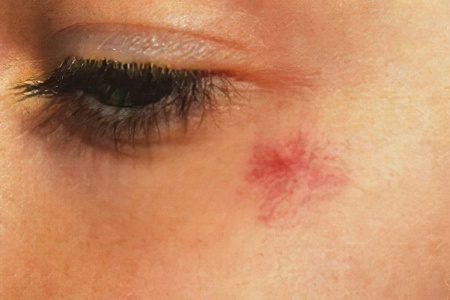Contents

Spider veins are an expansion of the network of capillaries in a limited area of the body in the subpapillary layer of the dermis or on the mucous membranes of a person. Enlarged capillaries protrude through the skin and form a visible purple or red gossamer effect. Venules, capillaries and arterioles may be involved in the process.
Most often, spider veins can be found on the wings of the nose, on the cheeks, if we are talking about the face. In addition, they can appear on the lower extremities. You can also meet the name of telangiectasia, which will also characterize the local expansion of the capillary network. Sometimes they are found even in the stomach.
Vascular asterisks can have a variety of shapes: arachnid, tree-like, linear, dotted. They are visible to the naked eye, therefore they represent a pronounced cosmetic defect, especially when localized on the face. According to statistics, spider veins on the face are found in 20-30% of adults, and women are most often affected. It is known that up to 80% of cases of spider veins occur in women who have gone through childbirth. Women taking oral contraceptives and undergoing estrogen therapy fall into the same risk group.
It should be understood that spider veins on the face in themselves are not a symptom of any disease and do not threaten health problems. However, they do not decorate the appearance, so many patients do not want to put up with them.
Causes of the appearance of spider veins on the face
There are several reasons that contribute to the appearance of spider veins on the face:
Causes due to congenital developmental features:
Congenital weakness of the connective tissue – BCCT. A person may suffer from the Ehlers-Danlos symptom, Marfan syndrome, etc.
Congenital cavernous and capillary hemangiomas.
Congenital neuroangiopathy and poikiloderma.
Progressive dilatation of congenital capillaries.
Causes that were acquired in the process of human life:
Autoimmune diseases, as well as immunodeficiency.
Stagnation of venous blood in the lower extremities.
Phlebeurysm.
Dermatological diseases, namely keratosis and annular telangiectatic purpura.
Metabolic diseases of the liver.
Diseases of the heart and blood vessels.
Hormonal disorders in a woman, the use of oral contraceptives. Abortions, miscarriages and even successfully completed pregnancies can negatively affect the state of blood vessels.
Increased vascular permeability due to lack of ascorbic acid.
Overweight.
Reasons for compensatory vasodilation:
Nerve strain.
Alcohol abuse, smoking.
Unbearable physical activity.
Injuries, including surgical wounds.
Difficult working conditions.
radioactive impact.
Overheating of the body.
Abuse of cleansing cosmetic procedures for the skin – the use of masks and facial peels, the application of warming masks.
[Video] Dr. Berg – What are the causes of varicose veins and spider veins?
Removal of spider veins on the face
One of the effective and modern methods of removing spider veins on the face is the procedure of laser photocoagulation. New lasers are able to determine with high accuracy the depth of the required impact and the diameter of the treatment zone, which makes it possible to select the optimal wavelength and radiation strength in each specific case.
Before proceeding with the procedure for removing spider veins, it is necessary to make sure that there are no diseases of the liver, uterus and ovaries, as well as the heart.
Laser removal
The method of laser photocoagulation is optimally suited for the removal of capillary-type spider veins. the modified vessel absorbs the laser beam, heats up to high temperatures and is sealed from the inside. Over time, complete resorption of the sealed capillaries will occur.
The impact is carried out aimingly and adjacent tissues are not damaged. To ensure that the patient does not experience discomfort, the treated area of the skin is necessarily cooled.
Sometimes one procedure is enough to remove a spider vein, although in some cases at least 10 procedures are required. This primarily depends on the area occupied by the altered vessels and on the severity of the capillary network.
The session itself is short in time and takes no more than 10 minutes. The maximum effect can be achieved in the treatment of small spider veins, which do not exceed 0,2 cm in diameter with localization on the nose and cheeks. However, the use of a laser to remove more massive formations on the lower and upper extremities is not ruled out.
[Video] Amina Pirmanova – types of lasers, which one to choose for a particular disease, indications, recommendations, secrets:









